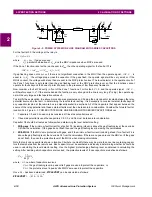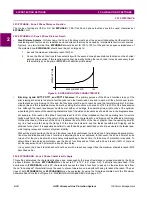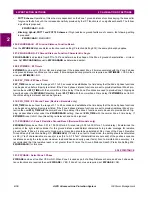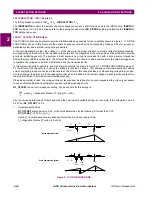
2-20
ALPS Advanced Line Protection System
GE Power Management
2.3 PROTECTION SETTINGS
2 CALCULATION OF SETTINGS
2
1.
If a longer setting is used, the reach should be checked per the maximum allowable reach procedure given
under Section 2.3.2: ZONE 2, ZONE 3, AND ZONE 4 DISTANCE FUNCTIONS on page 2–13. See Figure 2–
5: MAXIMUM ALLOWABLE REACH on page 2–13.
2.
If a shorter reach setting is used, then the reach should be checked to assure that the function will operate for
all faults that the remote Zone 2 function can operate for.
When series capacitors are used on the protected line or in lines adjacent to the protected line, set the Zone 4 phase
distance functions with a reach that is equal to or greater than the reach of the phase distance pilot tripping functions
(normally Zone 2) at the remote end of the transmission line. For example:
Z4PHREACH
≥
Z2PHREACH
R
where Z2PHREACH
R
is the reach of the pilot tripping functions (Zone 2 in this example) at the remote end of the line.
•
Step Distance and POTT2 Schemes: In all other schemes, the Zone 4 phase distance functions can provide an addi-
tional zone of time delayed backup protection. They can be used to provide a fourth zone of protection in a straight
step distance scheme, or they can be reversed in direction to provide the so-called reversed third zone of protection.
The Zone 4 functions should be set with a reach commensurate with the application, considering underreach caused
by intermediate fault current sources. Z4PHREACH should never be set so large as to:
1.
Exceed the maximum allowable reach (
MR), or,
2.
To cause loss of selectivity with phase distance functions providing time delayed backup on any adjoining line
section. If this requirement cannot be met by limiting the reach, then it may be necessary to get this selectivity
by setting timer Z4P_TIME with additional time delay.
403: Z4PCHARANG - Z4 Phase Characteristic Angle
•
Blocking, Hybrid and POTT2 Schemes: Set the Zone 4 characteristic angle setting to 10° less than the characteristic
angle setting (Z2PCHARANG
R
) of the Zone 2 functions at the remote terminal of the line; that is:
Z4PCHARANG = Z2PCHARANG
R
– 10°
•
Step Distance and POTT1 Schemes: This setting determines the characteristic shape and, consequently, the area of
resistance coverage provided by the Zone 4 phase distance functions. Z4PCHARANG can be set to 80° to 120° in 5°
steps. A 90° setting is recommended; values lower than 90° should not be used except in blocking, hybrid and POTT2
schemes. If the desired reach, Z4PHREACH, with a 90° characteristic and with maximum load flow does not allow the
maximum allowable reach criteria to be met, then a "lens-shaped" characteristic must be used. The settings of
Z4PHREACH and Z4PCHARANG may be evaluated by using the formula associated with the method of Figure 2–5:
MAXIMUM ALLOWABLE REACH on page 2–13.
405: Z4GRND - Z4 Ground Distance
Z4GRND can be set to YES or NO and determines whether or not the functions are to be used in the application.
•
Blocking, Hybrid, and POTT2 schemes: The Zone 4 ground distance functions are always required in these
schemes; therefore, set Z4GRND = YES
•
Step Distance and POTT1 Schemes: If the Zone 4 ground distance functions are to be used to provide time delayed
backup protection, then set Z4GRND = YES, otherwise, set Z4GRND = NO.
406: Z4GRDREACH - Z4 Ground Reach
•
Blocking, Hybrid, and POTT2 Schemes: In a blocking scheme, the Zone 4 functions key the transmitter to send a
blocking signal to the remote terminal of the line to block tripping for an external fault (F1 for example) within reach of
the Zone 2 functions located at the remote terminal (see Figure 2–10: ZONE 4 FAULT EXAMPLE on page 2–19).
In a hybrid scheme, the Zone 4 functions prevent keying of the transmitter to block echoing of the trip signal received
as a result of the operation of the remote Zone 2 functions for an external fault (at F1 for example) within their reach.
In a POTT2 scheme the Zone 4 functions establish transient blocking circuitry to prevent tripping during fault clearing
and fault current reversals.
In all of these schemes, it is imperative that the blocking functions be set with a reach that will allow them to see all
faults that the remote Zone 2 functions will see. The following guidelines are proposed:











































